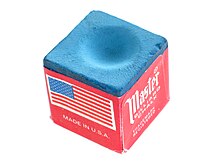Billiard chalk


The Chalk is the Pomeranze at the cue tip applied. It ensures better static friction between the bitter orange and the ball, especially when playing with spin .
The chalk is offered in the form of paper-coated cubes or cylinders (circle and octagon). Such a chalk cube usually has an edge length of approx. 2 cm.
Billiard chalk is available in many colors. Blue chalk is usually used for pool billiards , while snooker players prefer green chalk, which leaves less visible marks on the cloth and is finer granulated. The main component of billiard chalk (with over 90%) is silicon dioxide , i.e. quartz. Contrary to what is often claimed, these do not differ in their fat content - they do not contain any measurable fat content - but only in their water content, color and granulation. Rather, the expression “greasier” describes how strongly the chalk sticks to the white ball after the hit.
A more recent development especially for snooker is a chalk with an even finer grain, which should result in better contact between the bitter orange and the cue ball and also less adhesion to the cue ball (risk of kicking).
Individual evidence
- ↑ What is billiard chalk for? Billiard accessories, September 30, 2011, archived from the original on December 11, 2017 ; accessed on December 11, 2017 .
- ↑ Billiard chalk is not billiard chalk - the Kamui. Billiards tips, archived from the original on December 11, 2017 ; accessed on December 11, 2017 .